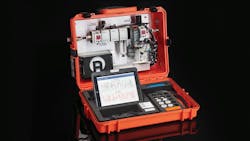Once they understand the concept of the Industrial Internet of Things (IIoT), the one question most companies have about it is: How do we get started?
Since no one wants to begin with anything too ambitious yet still be able to capture quantifiable results, Emerson has introduced a new tool to help pneumatic system users see the benefits of IIoT through data gathered from the company’s own equipment. By connecting Emerson’s new Aventics Smart Pneumatics Analyzer to the compressed air supply on an existing machine, Emerson says users can have access to instant analysis options for key machine characteristics, such as compressed air consumption and possible leakages.
The Aventics Smart Pneumatics Analyzer detects the system operating state, analyzes data, and provides processed information to users for status-oriented maintenance. While other similar technologies collect all available data and transfer it unfiltered, Emerson points out that the Smart Pneumatics Analyzer evaluates the data locally and uses it to generate information about the status of the system.
All data from the machine’s valves, as well as from components connected to the I/O modules on the valve system, are read into the analyzer’s microprocessor and processed via algorithms. These algorithms are based on Aventics pneumatic product engineering and applications (Emerson acquired Aventics in 2018).
The analyzer unit is a portable device in a case that contains a Smart Pneumatics Monitor, AS series air preparation units, and a tablet for visualizing the live data. With this device, Emerson says it can show a user within minutes how to use IIoT-enabled data for insights into their machines.
Emerson notes that the analyzer can be used to collect data for condition monitoring to anticipate wear before it leads to machine downtimes. Once user-defined limits are reached, the analyzer can automatically send messages to ERP and MES systems, as well as maintenance or other staff. The company adds that data collected by the analyzer can also help optimize a pneumatic systems’ energy efficiency.
Leaders relevant to this article:


